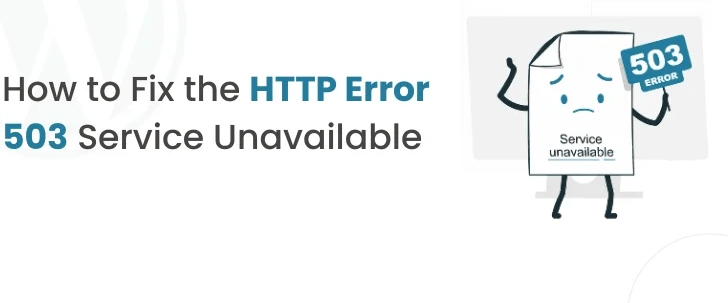


In this blog, we’ll cover what this error means, the common causes, and how you can fix it.
Encountering the HTTP Error 503: Service Unavailable can be frustrating for both website owners and visitors. This error occurs when the server is temporarily unable to handle the request, either due to being overloaded or undergoing maintenance. Unlike some other server errors, the 503 error is often temporary and can usually be resolved fairly easily once the cause is identified. In this blog, we’ll cover what this error means, the common causes, and how you can fix it.
The 503 Service Unavailable error indicates that your web server is temporarily unable to handle the request made by the browser. The key thing to remember is that it’s typically a server-side issue and is often a sign of temporary problems rather than a more permanent or damaging issue.
The error doesn’t offer much detail about what exactly is wrong, which is why troubleshooting can be a bit complex. However, it almost always stems from issues related to the server’s availability or capacity.
One of the most frequent causes of the 503 error is server overload. This can happen when your site receives a sudden spike in traffic, or if your server resources are not sufficient to handle current traffic demands.
Some web hosts may return a 503 error when the server is undergoing scheduled maintenance. In these cases, the error is typically temporary, and service will return once the maintenance is complete.
Sometimes, the error is caused by improper server configurations. This could involve incorrect settings in your web server or application server that prevent requests from being processed.
Distributed Denial of Service (DDoS) attacks are a malicious attempt to overwhelm your server with fake traffic, causing it to become unresponsive. A surge of incoming requests could result in a 503 error until the attack subsides or is mitigated.
Your hosting environment may have limited memory, CPU, or storage. If these resources are maxed out, the server might fail to respond to incoming requests, triggering the 503 error.
On some websites, especially WordPress sites, a malfunctioning plugin or script may cause the 503 error. When a plugin is incompatible or corrupted, it may overwhelm the server, preventing it from processing requests.
Now that you know some of the common causes, let’s dive into the steps you can take to fix the issue.
Before doing anything else, check if the server is down for scheduled maintenance or an unexpected outage. You can do this by contacting your hosting provider or checking their status page (if available). If the issue is related to server maintenance, it should resolve on its own.
If the issue isn’t maintenance-related, try restarting your server. Restarting the server clears out temporary issues, such as a memory overload or runaway processes, which could be causing the 503 error.
If your server is overloaded, either due to high traffic or insufficient resources, this could be the root cause of the problem. Check your server’s CPU, RAM, and disk space usage. If you’re nearing or exceeding your limits, consider upgrading your hosting plan or adding more resources to accommodate the traffic.
If you suspect that a plugin or theme is the cause, try disabling all plugins and then gradually re-enabling them one by one. This can help you identify the specific plugin causing the problem. If the 503 error disappears after disabling a plugin, that plugin may need to be updated or replaced.
If you’re regularly running into 503 errors due to high traffic or resource constraints, you may need to scale up your server’s capacity. Upgrading your hosting plan to one with more resources, such as moving from shared hosting to a Virtual Private Server (VPS) or dedicated hosting, can help prevent future 503 errors.
While the HTTP Error 503: Service Unavailable can be a temporary inconvenience, it’s important to address it quickly to avoid losing visitors or revenue. By following these steps—checking server status, managing resource usage, and disabling problematic plugins—you should be able to resolve most 503 errors with ease. If the issue persists, consider contacting your web host for further assistance.
